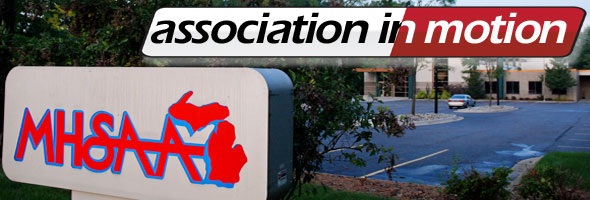
MI Participation Ahead of National Pace
September 10, 2018
By Geoff Kimmerly
Second Half editor
Michigan had the eighth-most participants in high school sports nationally for the second straight year in 2017-18 according to statistics recently released by the National Federation of State High School Associations, again outpacing the state’s national ranking of 10th for total number of residents of high school age.
Michigan’s participation ranking was based on a number of 296,625, with 127,098 girls and 169,527 boys taking part in high school athletics, and included sports in which the Michigan High School Athletic Association does not conduct postseason tournaments. The totals count students once for each sport in which he or she participates, meaning students who are multiple-sport athletes are counted more than once.
The state’s girls participation ranked eighth nationally for the second straight year, while the boys participation figure improved to seventh, up one spot from 2016-17. However, as with overall population, Michigan continued to rank 10th for both females and males ages 14-17 according to the latest U.S. Census Bureau estimates from 2017.
A total of 19 sports bested the state’s overall national participation ranking of eighth by placing seventh or higher on their respective lists. Four Michigan sports improved in national ranking during 2017-18, while the state fell one spot in the rankings of three sports.
The most substantial improvement among Michigan sports came in girls volleyball, where Michigan moved up two spots to fourth – the same ranking it occupied for 2014-15 and 2015-16 before falling to sixth on the list a year ago. Competitive cheer rose one spot in the competitive spirit ranking to fifth, while girls swimming & diving moved up one spot to ninth and girls gymnastics moved up one position to 11th on its ranking list.
Two of three sports that fell on participation lists still outpaced Michigan’s overall participation rank – boys golf and boys tennis both fell from fifth to sixth, respectively. Girls lacrosse participation fell to 14th after five straight years ranking 13th nationally.
Other Michigan sports that ranked eighth or higher in 2017-18 were baseball (eighth), girls basketball (sixth), boys basketball (seventh), girls bowling (fourth), boys bowling (third), girls and boys cross country (both seventh), 11 and 8-player football (sixth and seventh, respectively), girls golf (fifth), boys ice hockey (fourth), girls and boys skiing (both third), girls softball (seventh), girls tennis (third), girls track & field (eighth), boys track & field (seventh) and boys wrestling (seventh).
Boys lacrosse, boys and girls soccer and boys swimming & diving participation all slotted ninth on their respective lists, holding to their 2016-17 rankings and placing still ahead of where Michigan slotted for high school-aged population. The football rankings were again notable in that Michigan slotted sixth for 11-player participation for the sixth straight year despite another sizable increase in the number of schools switching to the 8-player format.
National participation in high school sports in 2017-18 set a record for the 29th consecutive year with 7,979,986 participants – an increase of 16,451 from the year before. Girls participation increased for the 29th consecutive year with an additional 15,009 participants to set an all-time high of 3,415,306. Boys participation also set another all-time high with 4,564,680, an increase of 1,442 participants from 2016-17.
For the second consecutive year, competitive spirit (competitive cheer in Michigan) had the largest increase among girls sports with an additional 18,426 participants. Swimming and diving, lacrosse and golf showed the next greatest increases among girls sports. Boys soccer registered the largest gain among boys sports with 6,128 additional participants, followed by cross country.
Football (1,067,970) was down 1.7 percent from 2016-17, but again remained the most-played high school sport overall – and nationally, the number of schools sponsoring the sport increased 29 to 15,486. Boys track & field (600,097), boys basketball (551,373), girls track & field (488,492) and baseball (487,097) again rounded out the top five sports by participation, in that order.

Council Discusses Transfer, 5th-Quarter Rules in Charting Future Work During Fall Meeting
By
Geoff Kimmerly
MHSAA.com senior editor
December 18, 2025
The Representative Council of the Michigan High School Athletic Association considered several reports concerning ongoing business relevant to its member schools, discussed topics surrounding the MHSAA’s transfer and 5th-quarter rules, and conducted its annual elections among other activities during its Fall Meeting on Dec. 5 in East Lansing.
Generally, the Council takes only a few actions during its Fall Meeting, with topics often introduced for additional consideration and action during its meetings in March and May. The Council took only one action at this meeting, to approve its annual audit, but discussed several topics that will be delved into further throughout the remainder of this school year.
A significant portion of Council discussion regarded the MHSAA transfer and 5th-quarter allowance rules. The transfer conversation focused primarily on students who play as part of non-MHSAA sports organizations during their first year or years of high school but wish to then play at a member high school. The Council also received an update on the Transfer Tracker tool under development that will provide schools greater guidance on eligibility determinations by monitoring when students change schools after ninth grade.
The 5th-quarter conversation considered how allowances made in recent years in basketball, football, soccer, lacrosse, baseball and field hockey have aligned with the intent of that allowance – to help schools save subvarsity teams from elimination because of low participation by allowing athletes to play on varsity and subvarsity teams simultaneously over a set number of periods each week.
The Council received updates on this fall’s inaugural MHSAA Field Hockey Tournament and also on the first boys volleyball season to be played during Spring 2026. MHSAA staff also informed the Council on a baseball rule proposal that would require a double first base, recent viewership of NFHS Network broadcasts, and MHSAA Sports Medicine Advisory Committee discussions especially concerning the statewide shortage of athletic trainers in schools. Additional updates were provided on MHSAA athletic director Update meeting and in-service programs and other administrative topics.
The Fall Meeting also saw elections of Council officers for the upcoming year. Brighton athletic director John Thompson was reelected president after completing the previous president’s term this summer and fall. Calumet teacher and past athletic director Sean Jacques was reelected as Council vice president after completing Thompson’s term, and Vic Michaels, director of physical education and athletics for the Archdiocese of Detroit, was reelected as secretary-treasurer.
Additionally, Wyoming Godfrey-Lee Schools superintendent Arnetta Thompson and Freeland Middle School principal Jennifer Thunberg were appointed for second two-year terms on the Council.
The Representative Council is the legislative body of the MHSAA. All but five members are elected by member schools. Four members are appointed by the Council to facilitate representation of females and minorities, and the 19th position is occupied by the Superintendent of Public Instruction or designee.
The MHSAA is a private, not-for-profit corporation of voluntary membership by more than 1,500 public and private senior high schools and junior high/middle schools which exists to develop common rules for athletic eligibility and competition. No government funds or tax dollars support the MHSAA, which was the first such association nationally to not accept membership dues or tournament entry fees from schools. Member schools which enforce these rules are permitted to participate in MHSAA tournaments, which attract more than 1.4 million spectators each year.

